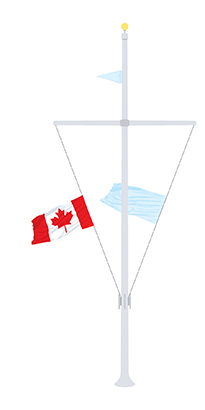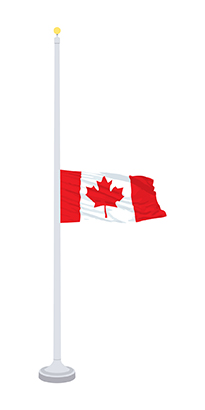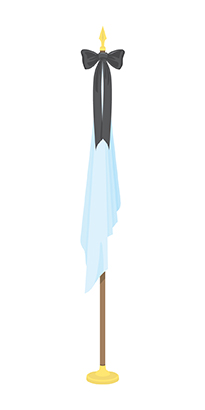Half-masting and flag etiquette in times of mourning
On this page
- Half-masting the National Flag of Canada
- Flags placed in mourning (draping)
- Personal Flags in situations of mourning
Half-masting the National Flag of Canada
Flags are half-masted as a sign of respect and to express a collective sense of sorrow during a time of national mourning. Given that national flags are recognized throughout the world as the ultimate symbols of their respective nations, the act of half-masting is a dramatic visual statement that speaks to the sense of loss that is shared by all their citizens.
Given the importance of the symbol of half-masting, the Government of Canada adopted the Rules for half-masting the National Flag of Canada to ensure a consistent approach to half-masting the National Flag at all federal buildings and installations. Similar rules are adopted by provinces, territories, municipalities and other organizations within their own jurisdictions.
They are not mandatory beyond the federal government, and other jurisdictions and organizations may have their own protocols. Individuals may also wish to fly the National Flag at half-mast to express mourning. In all cases, the Government of Canada’s half-masting protocols may serve as guidelines when expressing a collective sense of sorrow during a time of mourning.
As a general rule, when flying the National Flag or any other flag at half-mast, the centre of the flag should be exactly halfway down the flag pole.
When lowering a flag to the half-mast position, it must first be raised to the masthead (top of the flagpole) then lowered slowly to the half-mast position. To lower a flag that is at the half-mast position, the flag is first hoisted to the masthead, and then lowered completely. When the National Flag of Canada is flown with other flags, all flags in the immediate vicinity or part of the same flag group must be half-masted.
Flags are only half-masted on flagpoles that are fitted with halyards and pulleys. Some buildings fly flags from horizontal or angled poles, without halyards, on which the flags are permanently attached. Flags on these horizontal or angled poles are not half-masted.


When half-masting a stand of flags, the National Flag of Canada is lowered last. However, if it is possible to lower all flags in the stand at the same time, it is appropriate to do so.
Did you know?
You can find out why the National Flag of Canada is flying at half-mast on Parliament Hill and/or on Government of Canada buildings and establishments by consulting the Canadian Heritage website.
A flag that is flown at half-mast from the Peace Tower to honour the memory of a deceased person will be presented to the next of kin.
Flags flown at half-mast from other federal government buildings may be presented to the next of kin when it is deemed appropriate. These flags should be folded properly, respecting Canadian flag-folding etiquette, and then may be placed in an appropriate flag box or presentation box.
Did you know?
Flags that have been half-masted on the Peace Tower or other government buildings and presented to a deceased person’s next of kin are considered removed from active use and should never again be flown.
Flags placed in mourning (draping)
This practice was customary in former times but has faded in modern times. However, it is still acceptable to attach a cravat to a flag on an interior flagpole as a sign of mourning. The flagpole is placed at the entrance of the building (indoors, never outdoors). This allows the organization to visually honour the deceased while complying with the Government of Canada’s policy on flag etiquette.
The flag is draped with a piece of black crepe (ribbon), 2.5 m long, tied in a bow at the base of the finial so that the span of the bow is 30 cm. The ends, cut diagonally, should hang halfway down the sleeve of the flag.

A cravat is never attached to the National Flag of Canada, a Personal Flag of a member of the Royal Family, a Vice-Regal Flag or a Territorial Commissioner’s Flag, nor is it ever attached to an exterior flag. All other flags, such as organizational flags, may have a cravat in sign of mourning when permitted by their respective authority.
Personal Flags in situations of mourning
The Canadian Personal Flags of the members of the Royal Family, the Vice-Regal Flags and the Territorial Commissioner’s Flags are never flown at half-mast.
Upon the death of a serving Governor General, the flag is taken down and subsequently presented to the next of kin by an official designated by the Prime Minister. The same procedure applies for a serving Lieutenant Governor or Commissioner, but the Lieutenant Governor’s Flag would be presented by the Governor General or other designated official, and the Territorial Commissioner’s Flag by a senior official of the federal government.
Unlike the Royal Flags, which have historically been used to drape the casket of deceased members of the Royal Family, the Vice-Regal Flags should never be used to drape a casket.
The National Flag of Canada should be used to drape the casket of a deceased Governor General, by virtue of his/her function as a representative of The King of Canada. The National Flag or the Provincial Flag should be used in the case of a Lieutenant Governor and either the National Flag or the Territorial Flag in the case of a Commissioner.
Did you know?
The Governor General’s Flag has never been used to drape the casket of a deceased serving Governor General. For example, the Royal Union Flag was used for Lord Tweedsmuir and the National Flag was used for The Right Honourable Georges Vanier.